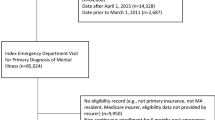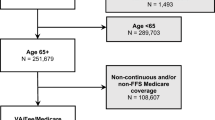Abstract
Frequent utilization of emergency department (ED) services contributes substantially to the cost of healthcare nationally and is often driven by psychiatric factors. Using national-level data from the Veterans Health Administration (VHA), the present study examined patient-level factors associated with ED use among veteran psychiatric patients. Veterans who had at least one ED visit with a psychiatric diagnosis in fiscal years 2011–2012 (n = 226,122) were identified in VHA administrative records. Andersen’s behavioral model of healthcare utilization was used to identify need, enabling, and predisposing factors associated with frequency of ED use (primary outcome) in multivariate regression models. Greater ED use was primarily linked with need (psychotic, anxiety, personality, substance use, and bipolar disorders) and enabling (detoxification-related service utilization and homelessness) factors. Chronic medical conditions, receipt of an opioid prescription, and predisposing factors (e.g., younger age) were also linked to greater ED use; however, the effect sizes for these factors were markedly lower than those of most psychiatric and psychosocial factors. The findings suggest that intensive case management programs aimed reducing frequent ED use among psychiatric patients may require greater emphasis on homelessness and other psychosocial deficits that are common among these patients, and future research should explore cost-effective approaches to implementing these programs.
Similar content being viewed by others
References
Simonet D. Cost reduction strategies for emergency services: insurance role, practice changes and patients accountability. Health Care Anal 2009; 17: 1–19.
Yoon J, Yano EM, Altman L, et al. Reducing costs of acute care for ambulatory care-sensitive medical conditions: the central roles of comorbid mental illness. Med Care 2012; 50: 705–13.
Leporatti L, Ameri M, Trinchero C, et al. Targeting frequent users of emergency departments: prominent risk factors and policy implications. Health Policy 2016; 120: 462–70.
Minassian A, Vilke GM, Wilson MP. Frequent emergency department visits are more prevalent in psychiatric, alcohol abuse, and dual diagnosis conditions than in chronic viral illnesses such as hepatitis and human immunodeficiency virus. J Emerg Med 2013; 45: 520–5.
Kushel MB, Perry S, Bangsberg D, et al. Emergency department use among the homeless and marginally housed: results from a community-based study. Am J Public Health 2002; 92: 778–84.
Moore DT, Rosenheck RA. Factors affecting emergency department use by a chronically homeless population. Psychiatr Serv 2016
Chang G, Weiss AP, Orav EJ, et al. Predictors of frequent emergency department use among patients with psychiatric illness. Gen Hosp Psychiatry 2014; 36: 716–20.
Smith MW, Stocks C, Santora PB. Hospital readmission rates and emergency department visits for mental health and substance abuse conditions. Community Ment Health J 2015; 51: 190–7.
Watkins KE, Pincus HA, Paddock S, et al. Care for veterans with mental and substance use disorders: good performance, but room to improve on many measures. Health Aff 2011; 30: 2194–2203.
Wagner TH, Sinnot P, Siroka AM. Mental health and substance use disorder spending in the Department of Veterans Affairs, fiscal years 2000–2007. Psychiatr Serv 2011; 62: 389–95.
Rosenheck RA, Fontana AF. Recent trends in VA treatment of post-traumatic stress disorder and other mental disorders. Health Aff 2007; 26: 1720–7.
Greenberg G, Rosenheck R. Department of Veterans Affairs national mental health program performance monitoring system: fiscal year 2007 report. West Haven, CT, Northeast Program Evaluation Center, 2008.
Hepner KA, Paddock SM, Watkins KE, et al. Program evaluation of VHA mental health services: client survey report. Alexandria, VA: Altarum Institute and RAND-University of Pittsburgh Health Institute, 2010.
Kessler C, Chen J, Dill C, et al. State of affairs of emergency medicine in the veterans health administration. Am J Emerg Med 2010; 28: 947–51.
Irmiter C, McCarthy JF, Barry KL, et al. Reinstitutionalization following psychiatric discharge among VA patients with serious mental illness: a national longitudinal study. Psychiatri Q 2007; 78: 279–86.
Noronha SF, Desai PN. Psychiatric emergency services in the veterans health administration: a review. New Directions Ment Health Serv 1999; 82: 75–84.
Doran KM, Raven MC, Rosenheck RA. What drives frequent emergency department use in an integrated health system? National data from the veterans health administration. Ann Emerg Med 2013; 62: 151–9.
Edens EL, Kasprow W, Tsai J, et al. Association of substance use and VA service-connected disability benefits with risk of homelessness among veterans. Am J Addictions 2011; 20: 412–9.
Hastings SN, Smith VA, Weinberger M, et al. Emergency department visits in veterans affairs medical facilitities. Am J Manag Care 2011; 17: e215-e223.
Tsai J, Rosenheck RA. Risk factors for emergency department use among homeless veterans. Am J Emerg Med 2013; 31: 855–8.
Timko C, Gupta S, Schultz N, et al. Veterans’ service utilization patterns after alcohol and opioid detoxification in VHA care. Psychiatr Serv 2016; 67: 460–4.
Goldberg RW, Gmyrek AL. Use of medical emergency departments by veterans with schizophrenia. Psychiatr Serv 2007; 58: 566–7.
Hansen TE, Elliott KD. Frequent psychiatric visitors to a veterans affairs medical center emergency care unity. Hosp Community Psychiatry 1993; 44: 372–5.
Huynh C, Ferland F, Blanchette-Martin N, et al. Factors influencing the frequency of emergency department utilization by individuals with substance use disorders. Psychiatr Q 2016.
Doupe MB, Palatnick W, Day S, et al. Frequent users of emergency departments: developing standard definitions and defining prominent risk factors. Ann Emerg Med 2012; 60: 24–32.
Andersen RM. Revisiting the behavioral model and access to medical care: does it matter? J Health Soc Behav 1995; 36: 1–10.
Babitsch B, Gohl D, von Lengerke T. Re-revisiting Andersen’s behavioral model of health services use: a systematic review of studies from 1998 to 2011. GMS Psychosocial Med 2012; 9: Doc 11.
Lindamer LA, Liu L, Sommerfeld DH. Predisposing, enabling, and need factors associated with high service use in a public mental health system. Adm Policy Ment Health 2012; 39: 200–9.
Yoon J, Scott JY, Phibbs CS, et al. Recent trends in veterans affairs chronic condition spending. Popul Health Manag 2011; 14: 293–8.
Coxe S, West SG, Aiken LS. The analysis of count data: a gentle introduction to Poisson regression and its alternatives. J Pers Assess 2009; 91: 121–36.
Cohen J, Cohen P. Applied multiple regression correlation analysis for the behavioral sciences. New York: John Wiley; 1975.
Muthén LK, Muthén BO. Mplus (version 7.4) [computer software]. Los Angeles: Muthén & Muthén; 2015.
Gellad WF. The veterans choice act and dual health system use. J Gen Intern Med 2016; 31: 153–4.
Pasic J, Russo J, Roy-Byrne P. High utilizers of psychiatric emergency services. Psychiatr Serv 2005; 56: 678–84.
Dickey B, Normand SL, Weiss RD, et al. Medical morbidity, mental illness, and substance use disorders. Psychiatr Serv 2002; 53: 861–7.
Maguen S, Madden E, Neylan TC, et al. Timing of mental health treatment and PTSD symptom improvement among Iraq and Afghanistan veterans. Psychiatr Serv 2014; 65: 1414–19.
Mackesy-Amit ME, Donenberg GR, Ouellet LJ. Prescription opioid misuse and mental health among young injection drug users. Am J Drug Alcohol Abuse 2015; 41: 100–6.
Lembke A. Why doctors prescribe opioids to known opioid abusers. N Engl J Med 2012; 367: 1580–1.
Moe J, Kirkland S, Rawe E, et al. Effectiveness of interventions to decrease emergency department visits by adult frequent users: a systematic review. Acad Emerg Med 2016.
Soril LJ, Leggett LE Lorenzett DL, et al. Reducing frequent visit to the emergency department: a systematic review of interventions. PLos One 2015; 10(44): e012360.
Bodenmann P, Velonaki VS, Griffin JL, et al. Case management may reduce emergency department frequent use in a universal health coverage system: a randomized controlled trial. J Gen Inter Med 2016.
Boudreaux JG, Crapanzano KA, Jones GN, et al. Using mental health outreach teams in the emergency department to improve engagement in treatment. Community Ment Health J 2015.
Nossel IR, Lee RJ, Isaacs A, et al. Use of peer staff in a critical time intervention for frequent users of a psychiatric emergency room. Psychiatr Serv 2016; 67: 479–81.
Yoon J, Lo J, Cowgill E, et al. Homeless veterans use of peer mentors and effects on costs and utilization in VA clinics. Academy Health Annual Research Meeting, Minneapolis, MN, 2015
Rodriguez RM, Fortman J, Chee C, et al. Food, shelter and safety needs motivating homeless persons’ visits to an urban emergency department. Ann Emerg Med 2009; 53: 598–602.
Tsemberis S, Gulcur L, Nakae M. Housing first, consumer choice, and harm reduction for homeless individuals with a dual diagnosis. Am J Public Health 2004; 94: 651–6.
O'Toole TP, Johnson EE, Aiello R, et al. Tailoring care to vulnerable populations by incorporating social determinants of health: the veterans health Administration's homeless patient aligned care team program. Prev Chronic Dis 2016; 13: E44.
Larimer ME, Malone DK, Garner MD, et al. Health care and public service utilization and costs before and after provision of housing for chronically homeless persons with severe alcohol problems. JAMA 2009; 301, 1349–57.
Sadowski LS, Kee RA, VanderWeele TJ, et al. Effect of a housing and case management program on emergency department visits and hospitalizations among chronically ill homeless adults: a randomized trial. JAMA 2009; 301: 1771–8.
Bradley EH, Elkins BR, Herrin J, et al. Health and social services expenditures: associations with health outcomes. BMJ Qual Saf 2011; 20: 826–31.
Lowe RA, Fu R, Ong ET, et al. Community characteristics affecting emergency department use by Medicaid enrollees. Med Care 2009; 47: 15–22.
Poremski D, Harris DW, Kahan D, et al. Improving continuity of care for frequent users of emergency departments: service user and provider perspectives. Gen Hosp Psychiatry 2016; 40: 55–59.
Comtois KA, Carmel A. Borderline personality disorder and high utilization of inpatient psychiatric hospitalization: concordance between research and clinical diagnosis. J Behav Health Serv Res 2016; 43: 272–80.
Author information
Authors and Affiliations
Corresponding author
Ethics declarations
Funding
This work was supported by the Department of Veterans Affairs (VA), Health Services Research & Development (HSR&D) (PPO 13–121: PI: Dr. Blonigen). Dr. Blonigen was also supported by a Career Development Award (CDA-2-008-10S) from VA Clinical Science Research & Development. Dr. Bi was supported by the VA Office of Academic Affiliations (TPP 62–500), and the VA Health Services Research and Development (HSR&D) Service in conjunction with a VA HSR&D Advanced Fellowship Program (TPP 97–006).
Disclosures
The views expressed are the authors’ and do not necessarily reflect those of the Veterans Health Administration. The authors report no conflicts of interest.
Electronic supplementary material
ESM 1
(DOCX 25 kb)
Rights and permissions
About this article
Cite this article
Blonigen, D.M., Macia, K.S., Bi, X. et al. Factors associated with emergency department useamong veteran psychiatric patients. Psychiatr Q 88, 721–732 (2017). https://doi.org/10.1007/s11126-017-9490-2
Published:
Issue Date:
DOI: https://doi.org/10.1007/s11126-017-9490-2




